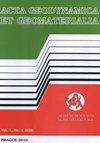Assessment of multi-GNSS precise orbit and clock products from different analysis centers based on precise point positioning
IF 0.8
4区 地球科学
Q4 GEOCHEMISTRY & GEOPHYSICS
引用次数: 1
Abstract
Performance of 24h static Precise Point Positioning (PPP) solutions based on multi-GNSS precise satellite orbit and clock products from four analysis centers and seven various constellation combinations was studied to evaluate their quality and characteristics. Data from ten European and four Chinese GNSS stations and 152 days long period from year 2020 were processed. Obtained coordinates were firstly compared with those provided by IGS final weekly combined solution. In Europe, the best agreement with this reference product was reached by solutions including Galileo signals, namely by a combination of GPS+GLONASS+Galileo systems with a mean RMS of 11 mm. This situation was different in China where inclusion of Galileo always led to worse results and the best agreement was achieved by a combination of GPS+GLONASS systems. Although product provided by German Research Center for Geosciences (GFZ) could be selected as the best performing over Europe and product by Center for Orbit Determination in Europe (CODE) over China, differences between individual precise products were mostly at a minimal level. Secondly, coordinates repeatability over the processed period was computed in order to assess the positioning stability. In this regard, the lowest values in both horizontal and vertical direction were reached by GPS+GLONASS solutions. From the perspective of precise products, the repeatability results were dependent on the selected constellation where mainly a specific behavior of product from Wuhan University (WUM) for Galileo system was observed. ARTICLE INFO基于精确点定位的不同分析中心多gnss精确轨道和时钟产品评估
研究了基于4个分析中心和7种星座组合的多gnss精密卫星轨道和时钟产品的24小时静态精确点定位(PPP)解决方案的性能,评估了其质量和特性。对欧洲10个GNSS站和中国4个GNSS站2020年以来152天的数据进行了处理。首先将得到的坐标与IGS最终周联合解提供的坐标进行比较。在欧洲,与该参考产品的最佳协议是通过包括伽利略信号的解决方案达成的,即GPS+GLONASS+伽利略系统的组合,平均RMS为11毫米。这种情况在中国是不同的,包括伽利略总是导致较差的结果,最好的协议是GPS+GLONASS系统的组合。虽然德国地球科学研究中心(GFZ)提供的产品在欧洲和欧洲定轨中心(CODE)提供的产品在中国表现最好,但单个精度产品之间的差异大多在很小的水平上。其次,计算处理周期内的坐标可重复性,以评估定位稳定性;在这方面,GPS+GLONASS解决方案在水平和垂直方向上都达到了最低值。从精确产品的角度来看,重复性结果依赖于所选择的星座,其中主要观察了武汉大学伽利略系统产品的特定行为。条信息
本文章由计算机程序翻译,如有差异,请以英文原文为准。
求助全文
约1分钟内获得全文
求助全文
来源期刊

Acta Geodynamica et Geomaterialia
地学-地球化学与地球物理
CiteScore
2.30
自引率
0.00%
发文量
12
期刊介绍:
Acta geodynamica et geomaterialia (AGG) has been published by the Institute of Rock Structures and Mechanics, Czech Academy of Sciences since 2004, formerly known as Acta Montana published from the beginning of sixties till 2003. Approximately 40 articles per year in four issues are published, covering observations related to central Europe and new theoretical developments and interpretations in these disciplines. It is possible to publish occasionally research articles from other regions of the world, only if they present substantial advance in methodological or theoretical development with worldwide impact. The Board of Editors is international in representation.
 求助内容:
求助内容: 应助结果提醒方式:
应助结果提醒方式:


